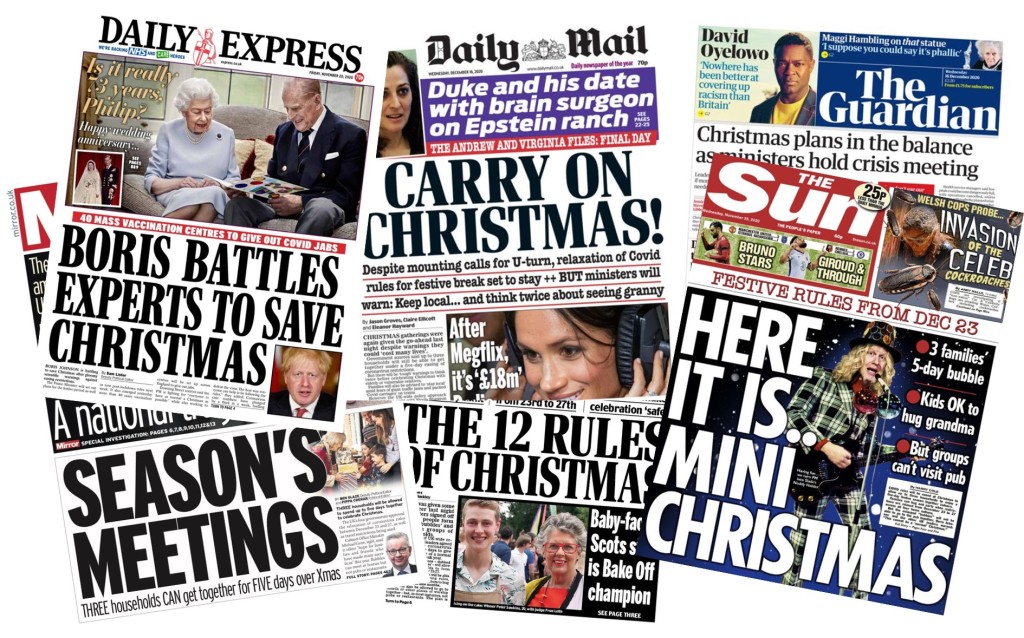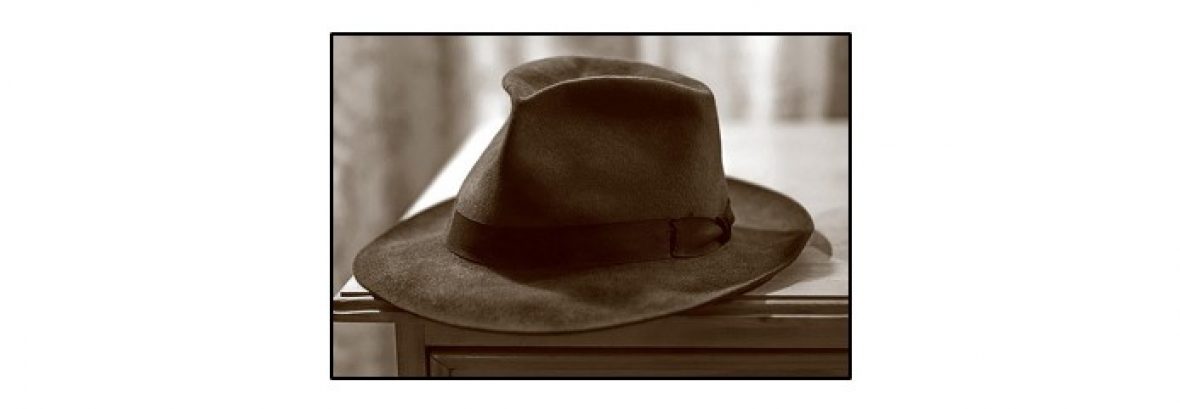
The Armistice that ended the first World War was signed at 5.10am on 11th November 1918, the subsequent ceasefire effective from 11am that morning. In the five or so hours between the signing and the ceasefire 2738 men were killed in fighting, their graves a monument to futility.
I am reminded of this lately whenever I hear people talk of a “near normal Christmas” at the very time when we await the start of the Covid-19 vaccination programme in the new year.
Disclosure: I am, I’m afraid, one of the new breed of armchair epidemiologists. Untrained, unqualified and wholly unreliable, what follows carries no professional authority whatsoever.
Christmas in our house is a performance in two parts; On Christmas Eve my side of the family come to ours for supper; my Dad, my brother and sisters and their families, together with our own brood and our granddaughter. Twenty-odd folk across four generations, us adults co-opting the excitement of the kids while they chatter about Santa Claus, clatter about the house and spill Cumberland sauce on the carpet.
Christmas Day and it’s the turn of my wife’s side of the family. Gathered for dinner at my sister-in-law’s, her boys home for the week with their partners, her partner’s family joining us, all of us suffering the taxi anxiety of my mithering mother-in-law. The mither-in-law, bless.
We’ve got school pupils and a teacher, health care professionals and a cancer patient, university students and a retired lecturer, and two octogenarians. In all, there are 33 people comprising 16 households from 6 areas of the UK jammed in to two houses over 24 hours in Glasgow.
I know this because I figured it all out and, in classic armchair epidemiologist style, turned it into a Venn diagram of interlinked households complete with virus transmission routes and risks. Having seen the picture for themselves my family think I’m nuts, and to be fair I share their concerns, but there you have it. There’s a shed load of us.
Each week the ONS publishes the results from its Covid-19 infection survey, a representative sample of over 100,000 people tested weekly to track the prevalence of the virus in the community. The most recent report estimates that more than 1% of the UK population has been infected with Covid-19 in the past week, with considerably higher prevalence amongst school kids and young adults. On this basis, were we to have Christmas tomorrow I reckon there’s about a 2/1 chance that at least one of our family group would be infectious.
We know that Covid-19 spreads by social interaction and that it spreads more readily with close contact. And we know that it spreads more easily in crowded indoor spaces, and more easily again over an extended period of time. A multigenerational Christmas dinner with a dozen or more people sat cheek by jowl for most of the day represents an utter feast for the virus. With two elders in their 80s and others with vulnerabilities, it’s not going to happen, is it.
In this light, and with three vaccines awaiting final approval, I’ve decided that this Christmas my singular job is to make sure that my Dad lives long enough to get vaccinated. That means I will continue not to see him indoors, and consequently he won’t spend time with us at Christmas this year. We’ll pop round to his place if the weather’s kind and chat in the garden as long as the cold allows, failing which it’ll be Zoom and the digital Christmas promised by Jason Leitch.
All of which is all very well and good, but it rather ignores everyone else’s point of view.
For me it’s a skoosh; I get to spend Christmas with my wife and our children while our wee granddaughter sprinkles the magics round the house. My father though needs to choose between three of his children, and between one set of grandchildren or another. My sisters are pitted one against the other, my brother hopelessly out-gunned, the grandchildren collateral damage. On the other side of the family things are no happier.
These are the dilemmas being faced by families up and down the country. With government guidance permitting 3 households to mix at Christmas, parents have to choose between their children, partners between their own family or their in-laws, elders between loneliness or infection risk. It’s horrid. There’s little comfort and joy in any of this. The human reaction is to make a little allowance for ourselves, bend the rules. It’s Christmas after all. Spread a little happiness.
However, the problems don’t end there. Although the government is permitting up to three households to mix, that doesn’t mean we ought to. The consequence of people moving across the UK and of increased social contact is an inevitable increase in infections. Around 25% of infected people have no symptoms of illness and are unaware that they’re infectious at all. Most others are infectious two or three days before symptoms emerge, oblivious to the risk they pose to close contacts meantime.
While ONS estimates a little more than 1% of people are currently infected, the prevalence of infection differs markedly across different areas of the country and between different groups. One consequence of permitting travel during the Christmas period is that infection rates will level up, areas with low rates receiving inbound infections from areas of higher prevalence.
In Scotland during the past week the rate of prevalence of infection is around 120 new cases per 100,000, but this hides significant differences regionally. On the mainland, the lowest rates of infection prevalence are in Dumfriesshire and in the Highlands, with fewer than 25 cases per 100,000 people reported in the last week. This compares with a rate of around 200 in Glasgow and Lanarkshire.
Across the UK the situation is worse. The rate in some areas of the Midlands is in excess of 400 cases per 100,000, with some towns on the east coast and in Kent reporting a rate of more than 600 recently. As people move from areas of higher prevalence to areas of lower prevalence to spend Christmas with family and friends, so the virus will move with them. More interaction means more infection, more infection means more illness, and more illness means more death. Such is the inescapable logic of Coronavirus.
I recall something said in the summer by Devi Sridhar, professor of Global Public Health at Edinburgh University, and an advisor to Scottish Government and SAGE. Following the release of the long springtime Lockdown, the reopening of the economy and the restart of international travel she predicted: “We will pay for our summer vacations with winter lockdowns”. It wasn’t a popular opinion at the time but sure enough, here we are in November with most of the UK living under the most severe restrictions.
What’s less acknowledged is where the virus came from this time around. Last month the Nextstrain project – a European collaborative research team tracking the spread of the virus – reported that around 80% of new infections in the UK during September and October were of a specific strain of the virus that originated in Spain in June. The inference drawn is that the current wave of the virus in the UK was seeded by holidaymakers returning home from Spain in the summer. And of course, in August we were all encouraged to eat out to help out. That helped out no end and the virus hasn’t looked back since.
Armed with this knowledge, and given current infection prevalence in the country, we can easily understand the risk of permitting mass travel across the UK at Christmas. We paid for summer holidays with winter lockdown, and it seems likely that we will pay for Christmas with a third wave in the New Year. Virtually every public health professional, epidemiologist and government advisor says the same.
This is particularly frustrating given the progress made in Scotland in recent weeks. The restrictions introduced in October with the start of the school holidays served to apply the brakes to an accelerating infection rate. Prevalence peaked towards the end of October and since then it has been steadily reducing, falling by more than 25% in the past fortnight. Indeed prevalence in Lanarkshire has halved this month. With the additional Tier 4 measures introduced in the central belt last week, we can expect the infection rate to fall further and faster next week and the following.
Moreover, the Scottish Government is considering extending the schools’ Christmas holidays to four weeks, and given what we saw following the week-long October break, we can expect a significant and positive impact on infections.
Recent experience in Scotland has shown that the sum of the changes we’ve made to our behaviour, together with the blend of tier 2 and tier 3 measures and the impact of contact tracing is effective in containing the virus. We can be confident that if we succeed in getting the infection rate to a low level, we can maintain it at a low level while the vaccination programme rolls out.
We’ve signed the armistice, we just need to sit tight and wait for the ceasefire.
In the meantime, Christmas. Thank goodness we don’t have a social tradition at Hogmanay.
This article was first published in Bella Caledonia in November 2020.
